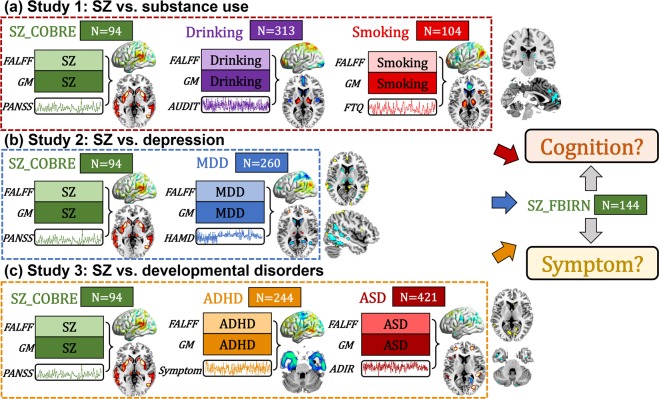The relevance of transdiagnostic shared networks to the severity of symptoms and cognitive deficits in schizophrenia: a multimodal brain imaging fusion study
Shile Qi1, Juan Bustillo2, Jessica A. Turner1,3, Rongtao Jiang4,5, Dongmei Zhi4,5, Zening Fu1, Thomas P. Deramus1, Victor Vergara1, Xiaohong Ma6,7, Xiao Yang6,7, Mike Stevens8, Chuanjun Zhuo9, Yong Xu10, Vince D. Calhoun1,3 and Jing Sui4,5,11
1Tri-institutional Center for Translational Research in Neuroimaging and Data Science (TReNDS), Georgia State University, Georgia Institute of Technology, Emory University, Atlanta, GA 30303, USA.
2 Department of Psychiatry, University of New Mexico, Albuquerque, NM 87131, USA.
3 Department of Psychology, Georgia State University, Atlanta, GA 30302, USA.
4 Brainnetome Center and National Laboratory of Pattern Recognition, Institute of Automation, Chinese Academy of Sciences, 100190 Beijing, China.
5 University of Chinese Academy of Sciences, 100190 Beijing, China.
6 Psychiatric Laboratory and Mental Health Center, The State Key Laboratory of Biotherapy, West China Hospital of Sichuan University, 610041 Chengdu, China.
7 Huaxi Brain Research Center, West China Hospital of Sichuan University, 610041 Chengdu, China.
8 Olin Neuropsychiatry Research Center, Hartford, CT 06106, USA.
9 Department of Psychiatry, Nankai University Affiliated Anding Hospital, 300222 Tianjin, China.
10Department of Humanities and Social Science, Shanxi Medical University, 030001 Taiyuan, China.
11Chinese Academy of Sciences Center for Excellence in Brain Science, Institute of Automation, 100190 Beijing, China
Abstract
Schizophrenia (SZ) is frequently concurrent with substance use, depressive symptoms, social communication and attention deficits. However, the relationship between common brain networks (e.g., SZ vs. substance use, SZ vs. depression, SZ vs. developmental disorders) with SZ on specific symptoms and cognition is unclear. Symptom scores were used as a reference to guide fMRI-sMRI fusion for SZ (n = 94), substance use with drinking (n = 313), smoking (n = 104), major depressive disorder (MDD, n = 260), developmental disorders with autism spectrum disorder (ASD, n = 421) and attention-deficit/hyperactivity disorder (ADHD, n = 244) respectively. Common brain regions were determined by overlapping the symptom-related components between SZ and these other groups. Correlation between the identified common brain regions and cognition/symptoms in an independent SZ dataset (n = 144) was also performed. Results show that (1): substance use was related with cognitive deficits in schizophrenia through gray matter volume (GMV) in anterior cingulate cortex and thalamus; (2) depression was linked to PANSS negative dimensions and reasoning in SZ through a network involving caudate-thalamus-middle/inferior temporal gyrus in GMV; (3) developmental disorders pattern was correlated with poor attention, speed of processing and reasoning in SZ through inferior temporal gyrus in GMV. This study reveals symptom driven transdiagnostic shared networks between SZ and other mental disorders via multi-group data mining, indicating that some potential common underlying brain networks associated with schizophrenia differently with respect to symptoms and cognition. These results have heuristic value and advocate specific approaches to refine available treatment strategies for comorbid conditions in schizophrenia.
 | Figure. Flowchart of the study design. The study design includes three sections: (a) Study 1: SZ_COBRE vs. substance use, (b) Study 2: SZ_COBRE vs. depression, (c) Study 3: SZ_COBRE vs. developmental disorders. First, we identify specific symptom-associated multimodal components for COBRE SZ, drinking, smoking, MDD, ADHD and ASD groups separately. Then the common brain regions were determined by overlapping the derived symptomrelated components of different diagnostic groups versus COBRE SZ (Study 1–3). Finally, correlation analysis was performed to evaluate how these identified brain regions associate with particular cognitive or symptomatic measures in an independent SZ dataset (FBIRN), which also test the replicability of our findings. |
